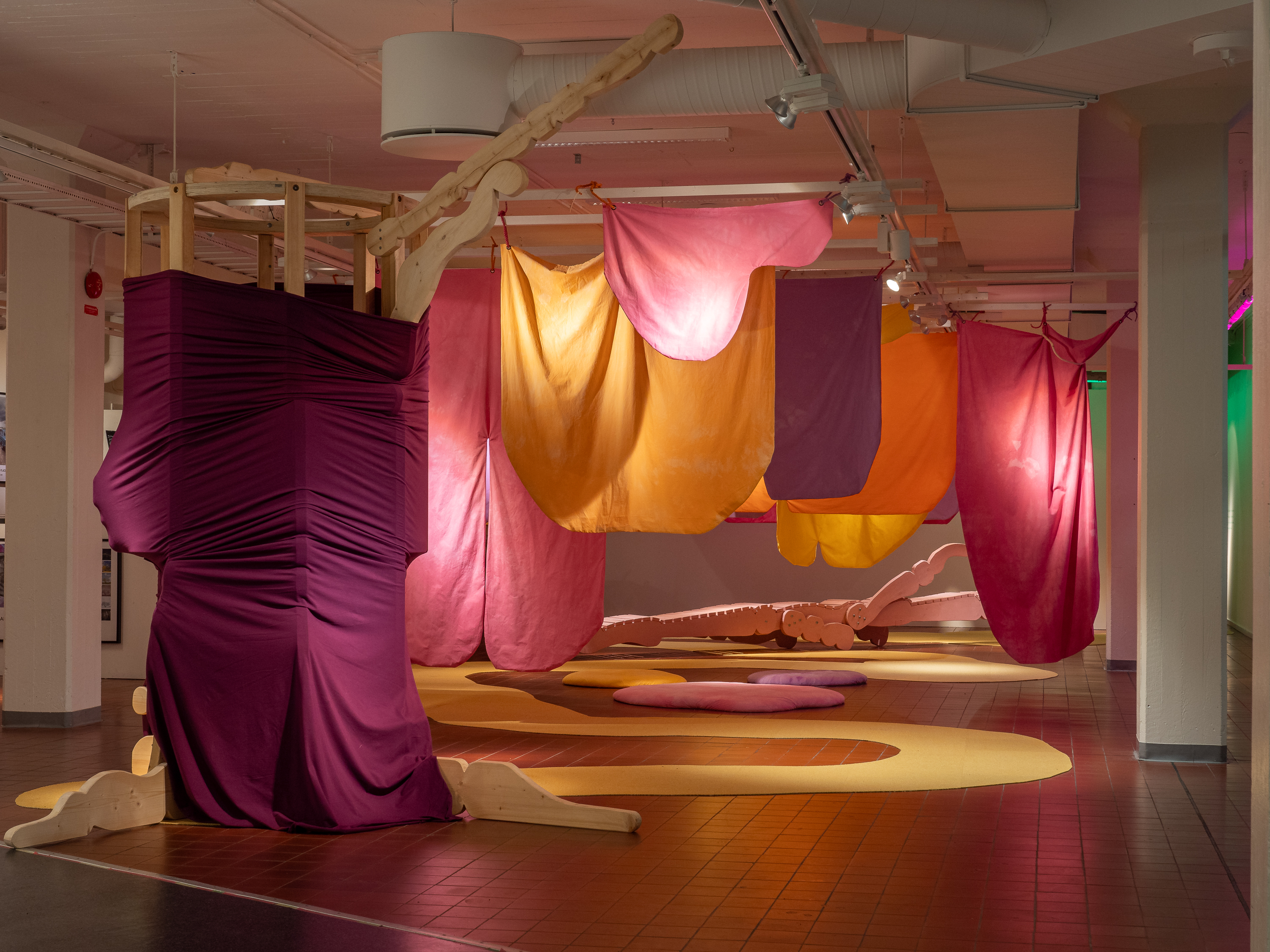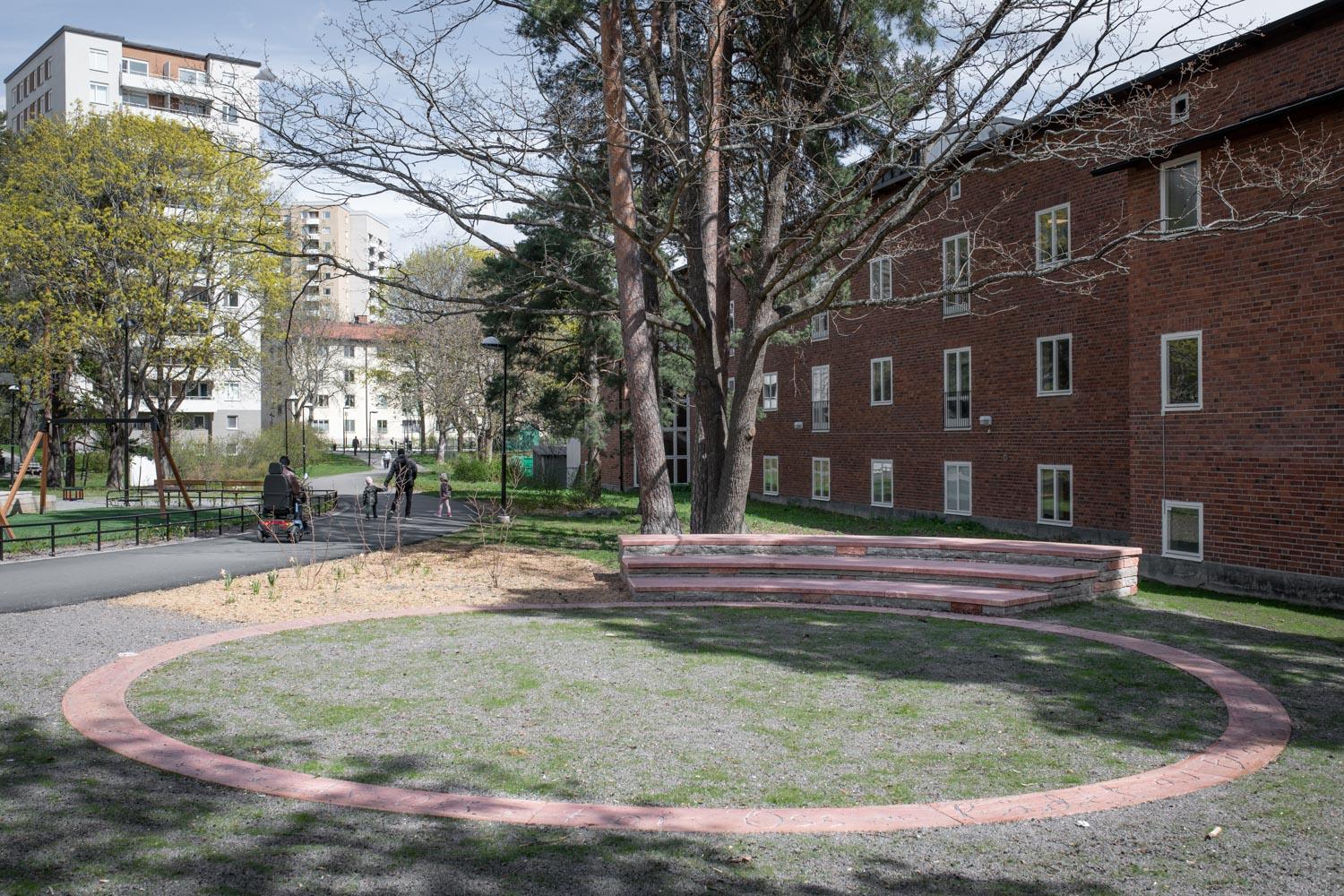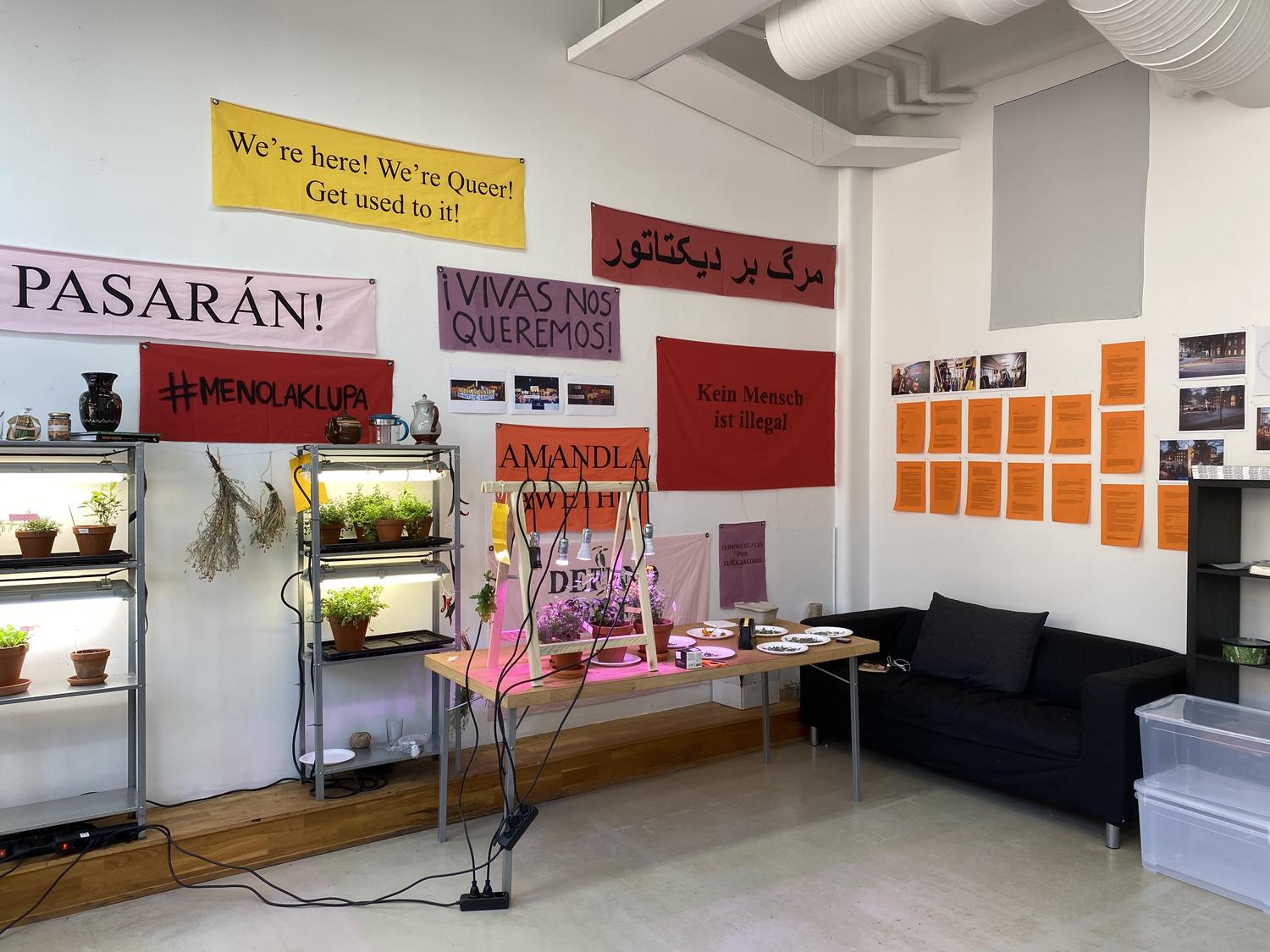The project Reorientations is a performance series by the artist duo aghili/karlsson. In dialogue with the queer and postcolonial philosopher Sara Ahmed's ideas about points of orientation, situations and spatial commonalities are created that orient us away from prevailing hierarchical (and violent) interactions. In collaboration with the American urbanist Jess Myers, conditions are formulated for conversation and work around the concept of "regional solidarity" which stands in opposition to the dichotomy urban-rural.
Reorientations has its starting point in the public space of the rural areas of Södertälje county and is the initiation of a thematic artist-run residency program. For the first edition, four artists from Sweden, Sápmi, Lebanon and Mexico, who are interested in questions concerning decoloniality, farming and ritual performative practices, were invited to attend a residency at aghili/karlsson's studio and their garden.
Reorientations has its starting point in the public space of the rural areas of Södertälje county and is the initiation of a thematic artist-run residency program. For the first edition, four artists from Sweden, Sápmi, Lebanon and Mexico, who are interested in questions concerning decoloniality, farming and ritual performative practices, were invited to attend a residency at aghili/karlsson's studio and their garden.
During the residency the artists meet horticulturalists, artists, botanists and residents of Södertälje and work towards a healing ritual that emerges from the place of the residency. The healing ritual was brought to a table, created by aghili/karlsson which were placed in (a) public space; nature reserves, fields and forests. At the table a performative conversation took place between the artist-in-residence and invited guests.
Reorientations is a continuation of the duo's work Safar – a performance series that revolves around utopian realities and takes invited guests and participants on a journey from central Stockholm to the duo's studio in the countryside outside Södertälje. Read more about Safar here
Reorientations is supported by Kulturrådet/Swedish Art Council, Konstnärsnämnden/The Swedish Arts Grants Committee, Region Stockholm and in collaboration with Södertälje Konsthall.
Reorientations is a continuation of the duo's work Safar – a performance series that revolves around utopian realities and takes invited guests and participants on a journey from central Stockholm to the duo's studio in the countryside outside Södertälje. Read more about Safar here
Reorientations is supported by Kulturrådet/Swedish Art Council, Konstnärsnämnden/The Swedish Arts Grants Committee, Region Stockholm and in collaboration with Södertälje Konsthall.
The table and the video versions of the performance conversations were exhibited at Södertälje Konsthall during September (2023). The performance conversations are now available to be experienced below.
Please note: This is a 360-viewing experience. On desktop, you can explore the 360 video with your mouse or arrow keys. On the Vimeo mobile app for iOS or Android, explore the 360 by dragging your finger across the screen. (360 video playback is not currently supported in any mobile browsers for iOS)
Participants: Cecilia Germain, Otilia Björndahl Joao, Sarasvati Shrestha, Nasim Aghili
The conversation between Cecilia and her invited guests starts with a ritual, by Cecilia called A Collective Afrofuturistic Libation. Cecilia puts four Vinca Minor in the ground next to the table. The table is placed in a grove outside of aghili/karlsson’s garden. For Cecilia this plant is a symbol and a guide in understanding the complex history of her black heritage, centered around survival and a respectful symbiotic relationship to plant life. After the ritual a conversation continues about land/soil in relation to diaspora and through cultivating as practice.
Participants: Dima Mabsout, Sarasvati Shrestha, Rami Khoury, Nasim Aghili, Björn Karlsson
Around the table, situated in a forest in Tullgarns nature reserve, sits Dima Mabsout and guests. They have walked there together using the moss, the trees, movement, the camera and Sara Ahmed as points of orientation. Dima starts the conversation by asking the guests how they use their artistic practice and personal history as orientation in relation to migration, the connection to soil and the dichotomy rural/urban.
Participants: Timimie Gassko Märak, Pussel Akatåps, Moa Johansson, Nasim Aghili
What’s the best thing with your queerness? The conversation between Timimie Gassko Märak and their friends starts with this question. Around the table, placed in a field in Yttereneby nature reserve, next to the ocean, a coffee ritual and a duodji hangout is played out. The conversation between the four participants centers their queerness - especially in relation to identity as a multi-minoritized person or raised in a rural setting - and how these experiences are expressed through clothes, crafts and community.
Participants: Vreni Michelini Castillo, Rossana Mercado-Rojas, Nasim Aghili, Björn Karlsson
Vreni Michelini Castillo invites their guests to the table, this time situated in a field in Hölö outside of Södertälje. The conversation raises questions about the participants' connections to rituals, collective celebrations and the historic and contemporary violence of colonialism and its consequences on both everyday life and on the spiritual landscapes of the guests. The conversation ends with Vreni presenting a sonic landscape capturing field recordings of Järna/Södertälje county, music from aghili/karlsson’s vinyl collection and quotes from books capturing the thematic undercurrents of the project Reorientations.






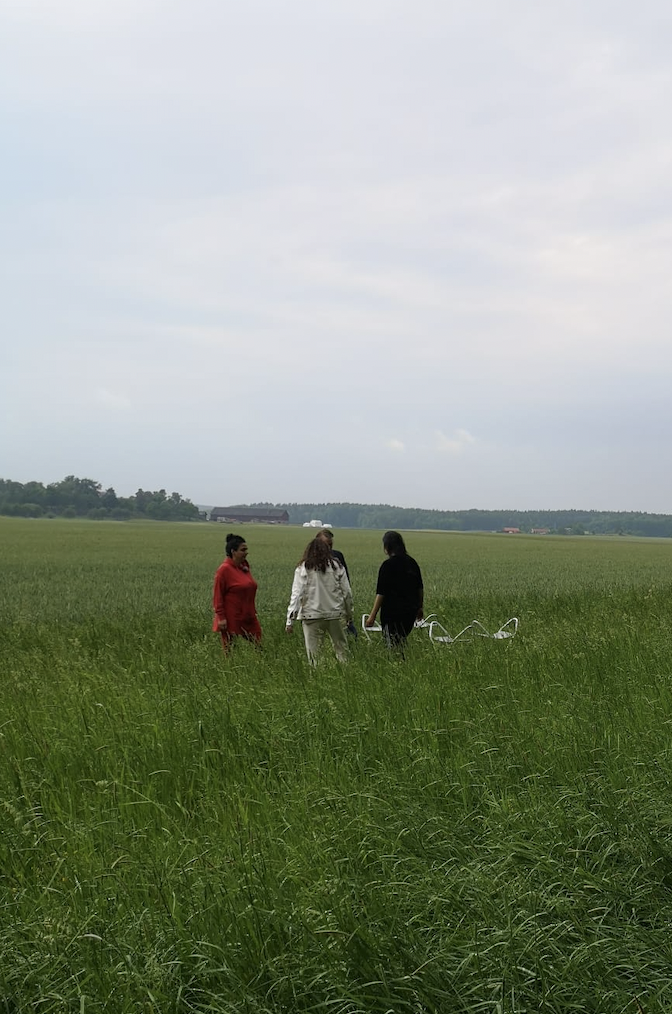

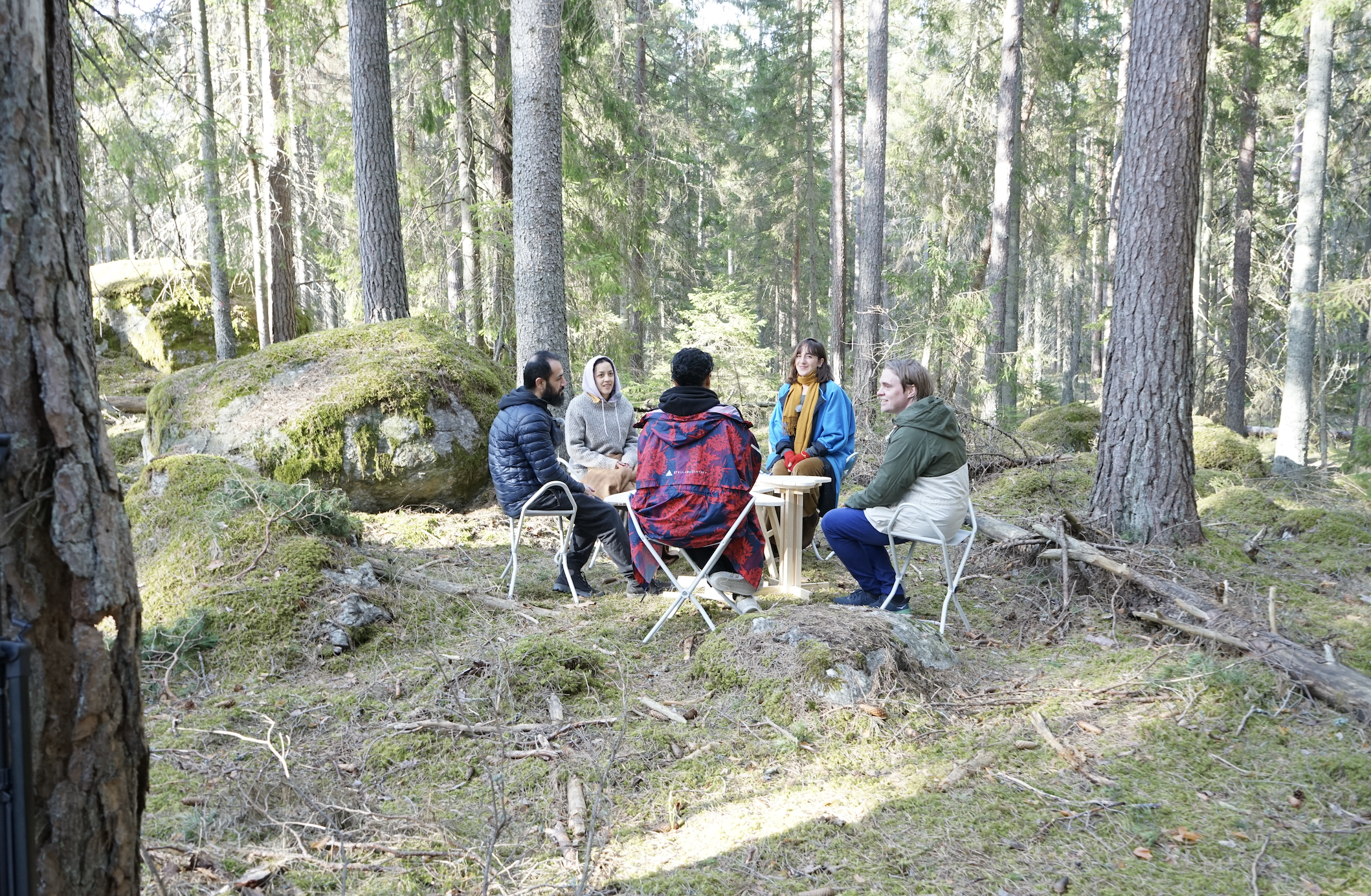


Foto: Moa Johnasson
VRENI MICHELINI CASTILLO
During their residency, Vreni Michelini Castillo will present a sonic landscape capturing field recordings of Järna/Södertälje county and the thematic undercurrents of Reorientations. They will also offer an introductory workshop to traditional Mexican medicine focused on the importance of limpias/cleansings.
BIO
Vreni Michelini Castillo is a transdisciplinary cultural producer, musician, curator & educator currently based in Oakland, CA.
Vreni was born in Guanajuato, México and grew up in Mexico City in the 90s. V has been a migrant since 1999, formed by the cultural context of Texas, Georgia and Virginia. They started producing art and music in 2007 within the migrant rights movement and hip hop scene in Richmond, VA. Vreni studied visual arts, craft and art history at VCU and art practice and ethnic studies at UC Berkeley.
Vreni’s practice involves art, performance, music, hip hop, writing, Mexican folk medicine, cultural organizing, traditional ecological knowledge & danza.
She is the co-founder of art collective Aguas Migrantes (2015-...), co-editor of Color Theory (2019) and creator of Fluid Mutualism (2021). She is the executive producer and creative engine of Chhoti Maa's Agua Corre (2014) and Caldo de Hueso (2016). She has been an artist in residence at VCUQ, Patio Taller, Root Division, Merritt Ceramics, WAM and ZooLabs.
Since 2007, Vreni has performed, exhibited, collaborated & taught in unceded Indigenous lands, Puerto Rico, Cuba, Spain, Qatar, U.A.E., Ghana, Peru, Colombia, Ecuador, Chile, Mexico, Sweden, USA and Canada. Vreni’s current research focuses on petroglyphs, amoxtlis, mycology, intersectionality and hip hop ecofemmenism.
TIMIMIE MÄRAK
The loud yet wordless language and stories of clothes, dress codes and community.
At the end of their residency, Timimie invited queer practitioners and artists to a workshop on crafting and skill-sharing. During one afternoon, the participants worked on their own project they brought with, or allowed the opportunity to learn a new skill, while conversing around the idea of finding new ways of communicating when invited into a space where one is safe to just be.
BIO
Timimie Gassko Märak puts just as much in between the lines they write as in the words they choose to share. Like them, their poetry is a combination of deep roots and connections, read at a big city pace. Speaker, poet and word weaver recently published in «Čatnosat. The Sámi Pavilion, Indigenous Art, Knowledge and Sovereignty.» and the first to hold the title of "Poet In Residence" at the Venice biennale.
Together with ‘The Sámi Pavilion’ curators Beaska Niillas and Liisa-Rávná Finbog, Märak is also one of the three founding members of Hásstuheaddji collective, a Sámi led think-tank that gather thinkers, performers and artists to dialogue and reflect.
They are the initiator of "Queerness and culture" a project created to combine the connection between generations learning from each other when passing on traditions with creating traditional regalia for queer and gender non conforming Sámis.
DIMA MABSOUT

The walk
At the end of the residency, Dima invited people to join a walk from Södertälje to Hölö crossing the 25km distance from the urban to the rural. Throughout the day, they walked with intention - as a meditation, a pilgrimage, a performative practice - with several pauses to engage with different sites, landscapes and in between spaces as they revisit our relationship to home. The day ended with a dinner at the house, a bonfire and a closing ritual.
The conversation
Dima brought the experience of the walk to the table to open up a conversation about migration, our relationship to land, territory, and the relativity of distance between communities. What role do artistic practices have in reimagining and reshaping our relationships? We will build on Sara Ahmed’s thoughts on ‘re-orientations’, as well as the personal experience and backgrounds of those gathered around the table.
BIO
Dima Mabsout is interested in how the arts can traverse borders, bridging between people, experiences, environments, and across social structures. Through interdisciplinary approaches, with focus on installation work, filmmaking, and performance, her practice focuses on educational and collaborative experiences that seek ways of relating we have not yet imagined. Currently based in Lebanon, she is part of Catalytic Action Design studio, Zayraqoun collective and several other cultural, social and educational initiatives.
At the end of the residency, Dima invited people to join a walk from Södertälje to Hölö crossing the 25km distance from the urban to the rural. Throughout the day, they walked with intention - as a meditation, a pilgrimage, a performative practice - with several pauses to engage with different sites, landscapes and in between spaces as they revisit our relationship to home. The day ended with a dinner at the house, a bonfire and a closing ritual.
The conversation
Dima brought the experience of the walk to the table to open up a conversation about migration, our relationship to land, territory, and the relativity of distance between communities. What role do artistic practices have in reimagining and reshaping our relationships? We will build on Sara Ahmed’s thoughts on ‘re-orientations’, as well as the personal experience and backgrounds of those gathered around the table.
BIO
Dima Mabsout is interested in how the arts can traverse borders, bridging between people, experiences, environments, and across social structures. Through interdisciplinary approaches, with focus on installation work, filmmaking, and performance, her practice focuses on educational and collaborative experiences that seek ways of relating we have not yet imagined. Currently based in Lebanon, she is part of Catalytic Action Design studio, Zayraqoun collective and several other cultural, social and educational initiatives.
CECILIA GERMAIN
"I began cultivating when I relocated to Ångermanland. A place I had no connection to. But I carried my mother's legacy with me. She enjoyed farming and I brought her pallet collars and a book by Lena Israelsson with me. I just did and it paid off. So that's how it started in 2009. For me, it began as a way of claiming space - to farm on foreign land.”
For the conversation, Cecilia brought four Vinca minor - a plant that for her functions as a symbol and tool for guidance toward a multifaceted history - and planted these in the ground of where the conversation took place. On the table, Cecilia had placed in a formation a few glasses containing water. In a ritual to invoking her ancestor from the African continent and the diaspora, the water was charged with several generations of knowledge and wisdom before it was used to water the newly planted Vinca minor.
BIO
Cecilia Germain is a Swedish-Canadian artist, educated at Konstfack in Stockholm and since 2005 works with questions and processes around power structures, historiography,memory work, grief, public health, spiritual- and healing practices.
In several pieces, Germain has focused on places, events and people’s relation to plants in the wake of colonial economies through olfactory works from botanical material where plants function as the link between soil/place and people's lives, traditions and visions. These were the themes in, for example, the work "Becoming Palmares" (Botkyrka art gallery 2021) where Germain throughout the exhibition period cultivated about thirty plants from seed that become a living botanical archive - a specific flora that can be connected to both the African continent but also the rich cultures of the African diaspora and multi-faceted knowledge of health, nutrition and medicine.
Cecilia Germain's interests and perspectives as an artist often stem from her own experience of belonging to the minority DOCS (Descendants of Chattel Slavery), the diaspora that came out of it the transatlantic slave trade. In addition to fragrance and archives, Germain also works with analog photography, graphic print, painting, performative and site responsive art, installation and text. Her works are represented in the Modern Museum's collection.

